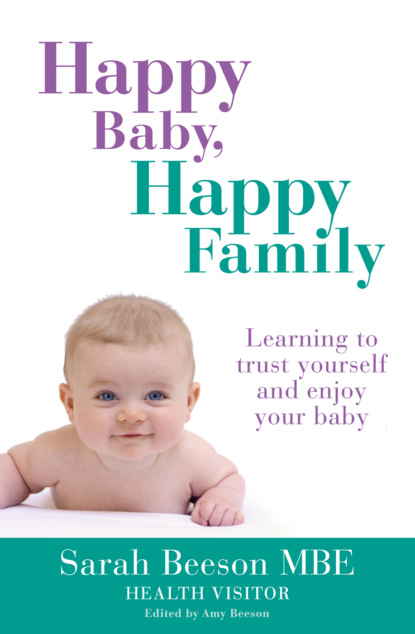По всем вопросам обращайтесь на: info@litportal.ru
(©) 2003-2024.
✖
Happy Baby, Happy Family: Learning to trust yourself and enjoy your baby
Автор
Год написания книги
2018
Настройки чтения
Размер шрифта
Высота строк
Поля
A small number of babies have Gastro-Oesophageal Reflux Disease (GORD) when acid from the stomach leaks out and backs up into the oesophagus. Sometimes this is confused with posseting, which is very common in new babies who frequently posset or vomit up some of their milk feed during or after a feed. In babies, reflux occurs when the milk feed ‘flows back’ up the baby’s food pipe and is either projectile-vomited or, in the case of silent reflux, is regurgitated back up in the oesophagus and swallowed again.
Reflux requires a professional medical diagnosis and treatment as the acid reflux may cause inflammation of your baby’s food pipe and affect their weight gain. If you think your baby has reflux and are worried they are not gaining weight and are in pain and distress, ask for a referral to a paediatrician to investigate and treat if needed.
Tongue-tie
Tongue-tie is when the frenulum, a short string-like membrane under the tongue, is tightly attached to the floor of the mouth rather than loosely attached. If your baby has trouble sticking out their tongue and it doesn’t go past their gums, or pulls into a heart shape, they may be tongue-tied. If your baby latches on and feeds well, and is gaining weight, they may not need any treatment. However, if your baby finds latching difficult and is not feeding well, ask your health visitor or doctor about whether they think it would help to clip the frenulum.
Winding
Wind is a build-up of gases in the stomach. With all the feeding your baby does there is inevitably a lot of wind in their tummy which causes gripe pains. By winding and burping your baby you are helping them to bring up some of that gas so they feel more relaxed and happier. (Winding techniques are described in the A–Z section.)
Moving on from breastfeeding when the time is right for you
There is no perfect time to give up breastfeeding; it is simply when the time is right for you. Many mums will experience a moment that signifies breastfeeding is coming to an end. It may be for practical reasons like returning to work, or it may be when biting becomes a problem, or that weaning is so established your baby is not showing much interest in breast milk these days. Don’t worry about what your friends are doing; some women may only breastfeed for the first few weeks; others will go on until their child is one or over. Whatever you decide, your baby has benefited hugely from the nourishment and time you have given them.
How to manage giving up breastfeeding if your baby is 0–6 months
If in the early weeks of breastfeeding you feel you want to stop and completely switch to formula, do try and drop one feed at a time if you can, rather than suddenly stopping altogether, which makes it hard on you physically (you’ll experience engorgement) and your baby (who will need time to adjust to taking formula from a bottle).
You may want your partner or someone else to give the bottle to start with, as it can be confusing for your baby to smell the milk on you and taste the formula at the same time. Once they are used to it, most babies will happily take the bottle of formula from Mum and some won’t care who gives it to them just so long as they get their milk. Do whatever is right for you and your baby. (You’ll find some helpful advice on bottle feeding in the next chapter.)
Strategies for giving up breastfeeding if your baby is over 6 months old
For mums who want to switch to formula from six months, it is best to drop one feed at a time and replace with a bottle. Babies who are weaning still need regular milk feeds, but when you give them is trial and error. Often it is the middle feed of the day that is easiest to switch first of all from breast to bottle. Your Little One should be easily taking their bottle before you drop another breastfeed. When you are both ready, try replacing the mid-morning breastfeed with a bottle, and then the mid-afternoon or tea-time feed. Pick the feeds where it makes sense or feels right to give the bottle. I know mums who’ve dropped the tea-time feed first because that is when their partner gets home from work and they can give the bottle instead.
The last feeds to go are usually the early-morning feed and finally the last feed before bed.
How long you take to do this is up to you. It may be that for practical reasons such as returning to work it is something that has to be done over a few weeks. Alternatively, you may have the time to make a gradual change over months.
Dropping the breastfeeds one at a time sounds easy but it can be an emotional and challenging time for many women. You may have your own feeling of loss and even grief when switching to the bottle even if you have been expressing milk, or it might be a huge relief – there is no right or wrong way to feel. Giving up breastfeeding is a decision only you can make. Don’t put too much pressure on yourself and, if you can, go with the flow (no pun intended!). Look at the positives – you may find you have more energy, less of an appetite, or just a bit more time to yourself. Trust yourself; you love your baby more than anyone, so have confidence in your own skills and intuitive feelings, and you and your baby will settle into this new method and way of feeding. (For further advice on formula feeding or when to switch to cows’ milk, take a look at the next chapter.)
Trust Yourself Checklist
Here’s a few reminders for you to check off, so you can trust that you are doing everything you can to successfully breastfeed your baby.
Positioning – is the position you are using ensuring your baby is properly latched on and feeding for as long as they need?
Patience – are you setting aside time to feed where you feel comfortable and relaxed to help reduce frustration and anxiety?
Perseverance – are you taking it a day at a time, recognising the achievement of each day’s breastfeeding?
Are you aware of the three signs that your baby is getting enough milk?
2 (#ulink_09453a47-2424-523f-b4b0-a7ca9350590a)
The Secrets for Successful Bottle-feeding (#ulink_09453a47-2424-523f-b4b0-a7ca9350590a)
Both formula- and breastfeeding mums can use bottles to feed their baby. Whether you choose to bottle-feed from the start, after a few weeks, months or at an age when your baby can go straight onto cows’ milk, I know you’ll want to do the best for your baby. One of the most common issues mums who are bottle-feeding have told me they experience is feeling judged – that people think they are a bad mum because they aren’t breastfeeding their baby. Your decision to formula-feed is your business and no one else’s; you don’t need to explain yourself to other people (it doesn’t matter whether you are formula-feeding because you had difficulties breastfeeding or if it was something you didn’t feel was right for you – you don’t have to justify yourself to other people whether they are friends, family or even health professionals!).
Once you’ve started to bottle-feed, for whatever reason, embrace it and just look at all the positive things you are doing for your Little One every day. It may help if you let the people supporting you know if you feel guilty or that you are being judged. They will more than likely tell you what a good mum you are, and help create a shield from unwelcome comments.
Bonding with your baby during bottle-feeds
I know some mums do worry that if they aren’t breast-feeding they won’t be able to bond with their baby, but when you feed your baby with their bottle this can be a wonderful opportunity to connect and enjoy each other. Making the most of this one-on-one time will really make a difference.
Look into your baby’s eyes, hold their gaze, sing to them, talk to them and hold their tiny hand. Your baby knows your voice so well; they heard it while they were in your womb, and will get a lot of reassurance from just being close to you, hearing your heartbeat and the sound of your breathing. This will help to encourage attachment between you and your baby, and dads can get in on the act, too.
Bottle-feeding in a calm and relaxed environment where you and your baby can focus on each other will have huge benefits. Enjoy this time, and the extra cuddles you can give them while winding them as you rub their back – it is all precious time between you and your baby. You’ll find a feeding technique and a space that is right for you. There is no reason why you can’t use feeding time to put your feet up and enjoy some quality time together.
Working with your partner as a team
If your partner does want to do their share of bottle-feeds, that is great news. It’ll give you a break and help them establish a stronger connection with the baby. I have known dads who’ve held back because they are worried they’ll break the baby. OK, you do need to be gentle, and I know dropping your baby is sometimes a big fear, but as long as you are sensible all will be well. Babies are very resilient so don’t be afraid to handle your Little One – you both will be experts in no time, and they will love a bit of daddy time.
Be gentle, but hold your baby securely. Often dads have a deft touch when it comes to comforting the baby; this may be because the hold is firmer. Parenthood is a partnership; you could take it in turns to feed and then swap over to settle – just do whatever works for you.
If you are still producing a little breast milk it is often best if your partner gives the baby their formula milk and settles them. The smell of the breast milk may cause your baby to search for it and become confused, and this makes it harder for mums to feed and comfort their Little One. So working together when possible at feeding time will give your Little One more opportunity to adapt and get the milk they need.
If you’ve stopped breastfeeding it may take several days to completely stop producing milk, so stopping suddenly is not the best way. Try to replace one breastfeed at a time with a bottle, and then drop another every few days so you can have switched over in about one to two weeks.
If you feel that your breasts are hard and engorged, talk to your doctor to see if you need any medication to help.
Trust Yourself
Enjoy Feeding Time
Feeding time is the perfect time for babies to bond with their parents. Give yourself a bit of time to put your feet up, put some relaxing music on, dim the lights and take some time out with your baby.
Getting the right equipment for bottle-feeding
Whenever you choose to start giving your baby a bottle you are going to need a few things to get bottle-feeding underway.
Bottle-feeding Shopping List
The right size teats (sizes 1–3)
Bottles
Steriliser
Muslin
Bottle brush
Washing-up liquid
Pair of Marigolds
Washing up and sterilising safely






